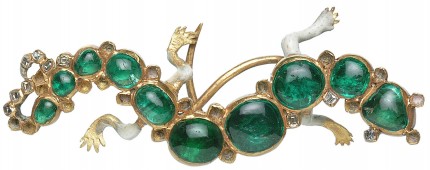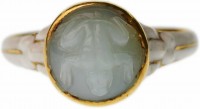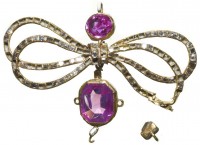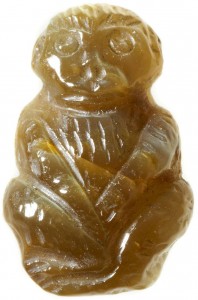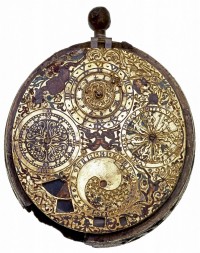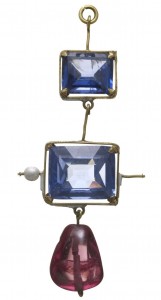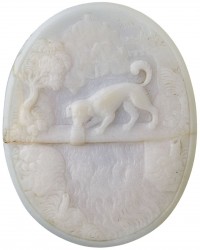 The Cheapside Hoard is an unprecedented collection of jewelry from the late 16th and early 17th century discovered in 1912 by workers demolishing the Wakefield House in Cheapside, London, near St. Paul’s Cathedral. They drove a pickaxe into the cellar floor and hit a decayed wooden box that had been hidden there centuries earlier before the Great London Fire of 1666. Inside the box were trays of jewelry, nearly 500 pieces made of gold, enamel and gemstones from all over the world. The workmen helped themselves to the jewels, wrapping them in handkerchiefs and stuffing them into their pockets, boots and caps so they could sell the treasures to a man known in the neighborhood as Stoney Jack.
The Cheapside Hoard is an unprecedented collection of jewelry from the late 16th and early 17th century discovered in 1912 by workers demolishing the Wakefield House in Cheapside, London, near St. Paul’s Cathedral. They drove a pickaxe into the cellar floor and hit a decayed wooden box that had been hidden there centuries earlier before the Great London Fire of 1666. Inside the box were trays of jewelry, nearly 500 pieces made of gold, enamel and gemstones from all over the world. The workmen helped themselves to the jewels, wrapping them in handkerchiefs and stuffing them into their pockets, boots and caps so they could sell the treasures to a man known in the neighborhood as Stoney Jack.
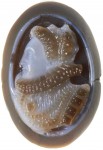 Stoney Jack was a familiar figure to construction workers in the area; he liked to hang out at demolition sites to snap up anything of interest that might be found. Fortunately for future generations, Stoney Jack wasn’t just some back alley fence. His real name was G.F. Lawrence. He owned an antiques store in Wandsworth and most importantly, he was head of acquisitions for the brand new London Museum which fortuitously opened the same year the Cheapside Hoard was discovered. Lord Harcourt, a founder of the London Museum, told Lawrence to seek out all the workers who had recovered hoard and buy whatever they were selling.
Stoney Jack was a familiar figure to construction workers in the area; he liked to hang out at demolition sites to snap up anything of interest that might be found. Fortunately for future generations, Stoney Jack wasn’t just some back alley fence. His real name was G.F. Lawrence. He owned an antiques store in Wandsworth and most importantly, he was head of acquisitions for the brand new London Museum which fortuitously opened the same year the Cheapside Hoard was discovered. Lord Harcourt, a founder of the London Museum, told Lawrence to seek out all the workers who had recovered hoard and buy whatever they were selling.
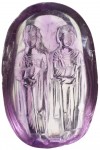 And that is how the upstart baby Museum of London acquired the most important collection of Elizabethan and Jacobean jewelry ever found, while the venerable British Museum had to make do with a gift of a few pieces and the prestigious Victoria & Albert was stuck with just a single gold and enamel chain. Now for the first time, the entire Cheapside Hoard will go on display at the Museum of London. The Cheapside Hoard: London’s Lost Jewels will run from October 11th, 2013, through April 27th, 2014, giving visitors a chance to see something that hasn’t been seen since 1912.
And that is how the upstart baby Museum of London acquired the most important collection of Elizabethan and Jacobean jewelry ever found, while the venerable British Museum had to make do with a gift of a few pieces and the prestigious Victoria & Albert was stuck with just a single gold and enamel chain. Now for the first time, the entire Cheapside Hoard will go on display at the Museum of London. The Cheapside Hoard: London’s Lost Jewels will run from October 11th, 2013, through April 27th, 2014, giving visitors a chance to see something that hasn’t been seen since 1912.
 It’s an exceptional sight to behold. The collection is heavy on the gemstones courtesy of the global range of mercantilism. There are emeralds from Colombia and Brazil, Brazilian amazonite, spinel, iolites and chrysoberyl from Sri Lanka, Indian rubies and diamonds, Persian turquoise, lapis lazuli from Afghanistan, Red Sea peridot, opals, garnets and amethysts from Bohemia and Hungary and pearls from Bahrain. There are spectacular individual pieces like a pocket watch set into a single Colombian emerald which before it was carved was the size of an apple, a 1,300-year-old Byzantine cameo carved out of amethyst, a gold, diamond and emerald hat pin in the shape of a salamander, a three-layer sardonyx cameo of Queen Elizabeth, an emerald parrot, incredibly delicate emerald and amethyst grape bunches hanging from gold and enamel branches.
It’s an exceptional sight to behold. The collection is heavy on the gemstones courtesy of the global range of mercantilism. There are emeralds from Colombia and Brazil, Brazilian amazonite, spinel, iolites and chrysoberyl from Sri Lanka, Indian rubies and diamonds, Persian turquoise, lapis lazuli from Afghanistan, Red Sea peridot, opals, garnets and amethysts from Bohemia and Hungary and pearls from Bahrain. There are spectacular individual pieces like a pocket watch set into a single Colombian emerald which before it was carved was the size of an apple, a 1,300-year-old Byzantine cameo carved out of amethyst, a gold, diamond and emerald hat pin in the shape of a salamander, a three-layer sardonyx cameo of Queen Elizabeth, an emerald parrot, incredibly delicate emerald and amethyst grape bunches hanging from gold and enamel branches.
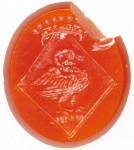 Many of the gemstones are cabochons, but there are also some more elaborate faceted cuts like rose-cut and star-cut which were first seen in Europe adorning France’s Cardinal Mazarin in the 1640s. Either those gems were cut just before they were buried, or rose and star cuts were being made or at least sold in England before they made their debut in France. Recent research done by Museum of London curator Hazel Forsyth has helped narrow down the burial date. One of the objects in the hoard is a small, chipped red seal stone intaglio. Carved on its face is the coat of arms of William Howard, the first and only Viscount Stafford. He was created Viscount Stafford in November of 1640, therefore the hoard had to have been buried after November 1640 but before September 1666.
Many of the gemstones are cabochons, but there are also some more elaborate faceted cuts like rose-cut and star-cut which were first seen in Europe adorning France’s Cardinal Mazarin in the 1640s. Either those gems were cut just before they were buried, or rose and star cuts were being made or at least sold in England before they made their debut in France. Recent research done by Museum of London curator Hazel Forsyth has helped narrow down the burial date. One of the objects in the hoard is a small, chipped red seal stone intaglio. Carved on its face is the coat of arms of William Howard, the first and only Viscount Stafford. He was created Viscount Stafford in November of 1640, therefore the hoard had to have been buried after November 1640 but before September 1666.
 Scholars believe the hoard was the stock of a jeweler or a group of jewelers who hid it for later retrieval. In the 17th century, Cheapside was known for its jewelry shops.
Scholars believe the hoard was the stock of a jeweler or a group of jewelers who hid it for later retrieval. In the 17th century, Cheapside was known for its jewelry shops.
“This collection has been misunderstood and misinterpreted, dismissed as jewellery for the merchant classes,” Forsyth said. “But at this date the merchants were among the wealthiest people in the land; they had far more disposable wealth than the aristocracy.”
In trying to find out who buried the treasure, when and why, she has solved some mysteries and may have uncovered a murder. Among the huge rubies, pearls the size of acorns, emeralds and sapphires, there were some faked stones made of quartz crystal carved and dyed to resemble precious gems. Forsyth believes these may have been the work of a jeweller called Thomas Simpson, known as a skilled but sharp operator. She also believes he may have been implicated in the murder of another jeweller, who was poisoned and thrown overboard on a voyage back from the orient, and that some of the gems the unfortunate victim was bringing back to London may have ended up in the hoard.
Nothing like a touch of murder to lubricate the international gem trade.
You can see more pictures of the Cheapside Hoard in this photo gallery, but none of them really do it justice. These beauties really need in-person viewing.
